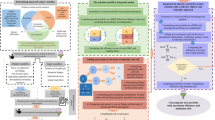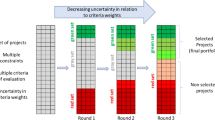Abstract
Despite academics’ and practitioners’ increasing focus on project portfolio management over the last three decades, very few methods and tools have been proposed for modeling and analyzing interdependencies among projects within a portfolio. This paper proposes the use of a novel approach that integrates three techniques: social network analysis (SNA), fuzzy technique for order of preference by similarity to ideal solution (TOPSIS), and cross-impact matrix multiplication applied to classification (MICMAC). Network mapping provides project managers with a holistic view of interdependencies among projects; fuzzy TOPSIS MICMAC and SNA measures are used to classify projects in terms of their driving power and dependence power and out- and in-degree centrality. This categorization offers a helpful tool for project managers to distinguish among projects and classify them based on their interdependency levels, and thus, aids in identifying critical projects. For the demonstration, the approach is applied to model and analyze interdependencies between projects within a real-life portfolio from the industry. The results of this application show that the proposed approach can serve as a viable and practical means of capturing and analyzing interdependencies among projects within a portfolio.
Similar content being viewed by others
References
Aaker DA, Tyebjee TT (1978) A model for the selection of interdependent R&D projects. IEEE Trans Eng Manag 25(2):30–36
Al Zaabi H, Bashir H (2018) Structuring project interdependencies into a Simple Graphical Hierarchical Model. Paper presented at the 2018 5th International Conference on Industrial Engineering and Applications (ICIEA). IEEE
Al Zaabi H, Bashir H (2019) Analyzing interdependencies in a project portfolio using social network analysis metrics. Paper presented at the 2019 International Conference on Industrial Engineering and Operations Management (IEOM)
Amiri MP (2010) Project selection for oil-fields development by using the AHP and fuzzy TOPSIS methods. Expert Syst Appl 37(9):6218–6224
Archer NP, Ghasemzadeh F (1999) An integrated framework for project portfolio selection. Int J Project Manag 17(4):207–216
Artto KA, Dietrich PH (2004) Strategic business management through multiple projects. In: Morris PWG, Pinto JK (eds) The Wiley guide to managing projects. Wiley, Hoboken, pp 144–176
Bardhan I, Bagchi S, Sougstad R (2004) Prioritizing a portfolio of information technology investment projects. J Manag Inf Syst 21:33–60
Batallas DA, Yassine AA (2006) Information leaders in product development organizational networks: social network analysis of the design structure matrix. IEEE Trans Eng Manag 53(4):570–582
Bathallath S, Smedberg Å, Kjellin H (2016) Managing project interdependencies in IT/IS project portfolios: a review of managerial issues. Int J Inf Syst Proj Manag 4(1):67–82
Bhosale VA, Kant R (2016) An integrated ISM fuzzy MICMAC approach for modelling the supply chain knowledge flow enablers. Int J Prod Res 54(24):7374–7399
Bilgin G, Eken G, Ozyurt B, Dikmen I, Birgonul MT, Ozorhon B (2017) Handling project dependencies in portfolio management. Proc Comput Sci 121:356–363
Blecic I, Cecchini A, Pusceddu C (2008) Constructing strategies in strategic planning: a decision support evaluation model. Oper Res Int J 8(2):153–166
Blichfeldt BS, Eskerod P (2008) Project portfolio management—there’s more to it than what management enacts. Int J Proj Manag 26(4):357–365
Borgatti SP (2002) NetDraw: graph visualization software. Analytic Technologies, Harvard
Bredillet C, Tywoniak S, Tootoonchy M (2018) Why and how do project management offices change? A structural analysis approach. Int J Proj Manag 36(5):744–761
Browning TR (1998) Use of dependency structure matrices for product development cycle time reduction. In: Fifth ISPE international conference on concurrent engineering: research and applications, Tokyo, Japan, pp 1–8
Chen CT (2000) Extensions of the TOPSIS for group decision-making under fuzzy environment. Fuzzy Sets Syst 114(1):1–9
Chen C-T, Cheng H-L (2009) A comprehensive model for selecting information system project under fuzzy environment. Int J Proj Manag 27(4):389–399
Clegg S, Killen CP, Biesenthal C, Sankaran S (2018) Practices, projects and portfolios: current research trends and new directions. Int J Proj Manag 36(5):762–772
Coldrick S et al (2005) An R&D options selection model for investment decisions. Technovation 25(3):185–193
Colvin M, Maravelias CT (2011) R&D pipeline management: task interdependencies and risk management. Eur J Oper Res 215(3):616–628
Cooper RG, Edgett SJ, Kleinschmidt EJ (1999) Portfolio management in new product development: lessons from the leaders, Phase I. In: Dyer LD, Pennypacker JS (eds) Project portfolio management. Center of Business Practices, West Chester, pp 97–116
Danilovic M, Browning TR (2007) Managing complex product development projects with design structure matrices and domain mapping matrices. Int J Proj Manag 25(3):300–314
Danilovic M, Sandkull B (2005) The use of dependence structure matrix and domain mapping matrix in managing uncertainty in multiple project situations. Int J Proj Manag 23(3):193–203
Dickinson MW, Thornton AC, Graves S (2001) Technology portfolio management: optimizing interdependent projects over multiple time periods. IEEE Trans Eng Manag 48(4):518–527
Dubey R, Ali SS (2014) Identification of flexible manufacturing system dimensions and their interrelationship using total interpretive structural modelling and fuzzy MICMAC analysis. Glob J Flex Syst Manag 15(2):131–143
Duperrin JC, Godet M (1973) Methode de hierarchisation des elements d’un systeme. In: Rapport Economique du CEA. Paris, pp 45–51
Eilat H, Golany B, Shtub A (2006) Constructing and evaluating balanced portfolios of R&D projects with interactions: a DEA based methodology. Eur J Oper Res 172(3):1018–1039
Formentini M, Romano P (2011) Using value analysis to support knowledge transfer in the multi-project setting. Int J Prod Econ 131(2):545–560
Ghapanchi AH, Tavana M, Khakbaz MH, Low G (2012) A methodology for selecting portfolios of projects with interactions and under uncertainty. Int J Proj Manag 30(7):791–803
Gorane SJ, Kant R (2013) Modelling the SCM enablers: an integrated ISM-fuzzy MICMAC approach. Asia Pac J Mark Logist 25(2):263–286
Groenveld P (1997) Road mapping integrates business and technology. Res Technol Manag 40(5):48–55
Hossain L, Ruwanpura J (2008) Optimization of multi-project environment (OPMPE). In: 2008 winter simulation conference. IEEE, pp 2421–2430
Hwang CL, Yoon K (1981) Methods for multiple attribute decision making. In: Beckmann M, Künzi HP (eds) Multiple attribute decision making. Springer, Berlin, pp 58–191
Isikli E, Yanik S, Cevikcan E, Ustundag A (2018) Project portfolio selection for the digital transformation era. In: Industry 4.0: managing the digital transformation. Springer, Cham, pp 105–121
Khorramshahgol R, Azani H, Gousty Y (1988) An integrated approach to project evaluation and selection. IEEE Trans Eng Manag 35(4):265–270
Killen CP (2013) Evaluation of project interdependency visualizations through decision scenario experimentation. Int J Proj Manag 31(6):804–816
Killen CP, Kjaer C (2012) Understanding project interdependencies: the role of visual representation, culture and process. Int J Project Manag 30(5):554–566
Kock A, Heising W, Gemünden HG (2016) A contingency approach on the impact of front-end success on project portfolio success. Proj Manag J 47(2):115–129
Kopmann J, Kock A, Killen CP, Gemünden HG (2015) Business case control in project portfolios—an empirical investigation of performance consequences and moderating effects. IEEE Trans Eng Manag 62(4):529–543
Kopmann J, Kock A, Killen CP, Gemünden HG (2017) The role of project portfolio management in fostering both deliberate and emergent strategy. Int J Proj Manag 35(4):557–570
Laslo Z (2010) Project portfolio management: an integrated method for resource planning and scheduling to minimize planning/scheduling-dependent expenses. Int J Proj Manag 28(6):609–618
Lee JW, Kim SH (2001) An integrated approach for interdependent information system project selection. Int J Proj Manag 19(2):111–118
Lee CY, Chong HY, Liao PC, Wang X (2017) Critical review of social network analysis applications in complex project management. J Manag Eng 34(2):04017061
Liesiö J, Mild P, Salo A (2008) Robust portfolio modeling with incomplete cost information and project interdependencies. Eur J Oper Res 190(3):679–695
Linstone HA, Turoff M (1979) The Delphi method: techniques and applications. Addison-Wesley, London
Meyer AD (1991) Visual data in organizational research. Organ Sci 2:218–236
Mishra N, Singh A, Rana NP, Dwivedi YK (2017) Interpretive structural modelling and fuzzy MICMAC approaches for customer centric beef supply chain: application of a big data technique. Prod Plan Control 28(11–12):945–963
Mohan VR, Paila AR (2013) Stakeholder management in infrastructure/construction projects: the role of stakeholder mapping and Social Network Analysis (SNA). Aweshkar Res J 15(1):48–61
Moreno JL (1960) The sociometry reader. Free Press, New York
Pedrycz W (1994) Why triangular membership functions? Fuzzy Sets Syst 64(1):21–30
Petrillo A, Di Bona G, Forcina A, Silvestri A (2018) Building excellence through the Agile Reengineering Performance Model (ARPM). Bus Process Manag J
Rungi M (2010) Success rate and resource consumption from project interdependencies. Ind Manag Data Syst 110(1):93–110
Rungi M, Hilmola OP (2011) PIM of projects: survey comparison between Estonia and Finland. Balt J Manag 6(2):146–162
Sanchez H, Robert B, Bourgault M, Pellerin R (2009) Risk management applied to projects, programs, and portfolios. Int J Manag Proj Bus 2(1):14–35
Santhanam R, Kyparisis GJ (1996) A decision model for interdependent information system project selection. Eur J Oper Res 89(2):380–399
Shackelford M, Corne D (2001) Collaborative evolutionary multi-project resource scheduling. In: Proceedings of the 2001 Congress on evolutionary computation. IEEE, New York, pp 1131–1138
Staudenmayer NA (1997) Managing multiple interdependencies in large scale software development projects (Unpublished doctoral dissertation). The Massachusetts Institute of Technology
Tavana M, Keramatpour M, Santos-Arteaga FJ, Ghorbaniane E (2015) A fuzzy hybrid project portfolio selection method using data envelopment analysis, TOPSIS and integer programming. Expert Syst Appl 42(22):8432–8444
Taylan O, Bafail AO, Abdulaal RM, Kabli MR (2014) Construction projects selection and risk assessment by fuzzy AHP and fuzzy TOPSIS methodologies. Appl Soft Comput 17:105–116
Teller J, Unger BN, Kock A, Gemünden HG (2012) Formalization of project portfolio management: the moderating role of project portfolio complexity. Int J Proj Manag 30(5):596–607
Tichy NM, Tushman ML, Fombrun C (1979) Social network analysis for organizations. Acad Manag Rev 4(4):507–519
Verma D, Sinha KK (2002) Toward a theory of project interdependencies in high tech R&D environments. J Oper Manag 20:451–468
Waggoner J, Carline JD, Durning SJ (2016) Is there a consensus on consensus methodology? Descriptions and recommendations for future consensus research. Acad Med 91(5):663–668
Wasserman S, Faust K (1994) Social network analysis: methods and applications, vol 8. Cambridge University Press, New York
Yassine A (2004) An introduction to modeling and analyzing complex product development processes using the design structure matrix (DSM) method. Urbana 51(9):1–17
Zadeh LA (1965) Fuzzy sets. Inf Control 8(3):338–353
Zadeh LA (1976) A fuzzy-algorithmic approach to the definition of complex or imprecise concepts. Int J Man Mach Stud 8(3):249–291
Zuluaga A, Sefair JA, Medaglia AL (2007) Model for the selection and scheduling of interdependent projects. Paper presented at the IEEE the Systems and Information Engineering Design Symposium, Charlottesville, April 27
Author information
Authors and Affiliations
Corresponding author
Additional information
Publisher's Note
Springer Nature remains neutral with regard to jurisdictional claims in published maps and institutional affiliations.
Rights and permissions
About this article
Cite this article
Al Zaabi, H., Bashir, H. Modeling and analyzing project interdependencies in project portfolios using an integrated social network analysis-fuzzy TOPSIS MICMAC approach. Int J Syst Assur Eng Manag 11, 1083–1106 (2020). https://doi.org/10.1007/s13198-020-00962-3
Received:
Revised:
Published:
Issue Date:
DOI: https://doi.org/10.1007/s13198-020-00962-3
Keywords
- Projects portfolio management
- Project interdependencies
- Social network
- Visual tools
- Fuzzy TOPSIS
- Integrated network-fuzzy cross-impact matrix multiplication analysis (MICMAC)









